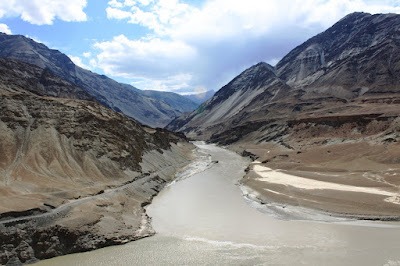
Image Soource: Kaushik Manghani
About Sangam
At Sangam, especially during winter, the Zanskar river freeze almost completely, forming the Chadar trek route. While the Indus remains partially open due to its larger volume and different origin (from the Tibetan Plateau). The Sangam at Nimo presents a stark contrast-one half is white with Ice the other is deep blue.
The reason for this contrasting colour can be found in the origin of the river from two different geologies. The Zanskar river originate in the Tethys Himalayas and finds silt and minerals. While the Indus flows through Trans-Himalayan terrain with heavier, rocky sediments. At the meeting point,a visible colour contrast —muddy brown Zanskar merging with turquoise Indus—which changes seasonally, looks beautiful to the eyes.
Sacred Energy Vortex for Monks
In locals, the sangam holds an important place. Local monks from monasteries like Spituk and Phyang believe the Sangam area has a unique spiritual energy vortex. Some perform meditation rituals on the nearby cliffs, considering it an auspicious point for seeking clarity and inner balance.
During ceremonies like Chams dance festivals, monks collect water from Sangam in silver vessels. It’s believed this water carries dual blessings from both rivers and is used in high-altitude monasteries for special rituals.
Strategic Observation Point in Ancient Times
In ancient times, the Sangma was used as lookout points by the Ladakhi kingdom to watch for trade caravans or approaching invaders from Baltistan. Remnants of watch shelters carved into the rocks still exist, though unmarked.
Near the banks, particularly on flat rock faces, there are ancient Tibetan and Kushan-era inscriptions , some possibly dating back to the 1st century CE. These inscriptions are not marked by any signage and are known mainly to researchers and locals.
Rare Double Migration Zone
Sangam lies along two avian migratory paths —one from Central Asia and the other from Tibet. As a result, it’s a hotspot for spotting rare birds like the Bar-headed goose and Ibisbill during autumn and spring.
Dynamic Land Formation
Every monsoon season, the sandbars and islands at the confluence shift in shape and size , creating temporary land masses that change the geography slightly each year—a phenomenon known as fluvial island formation .
